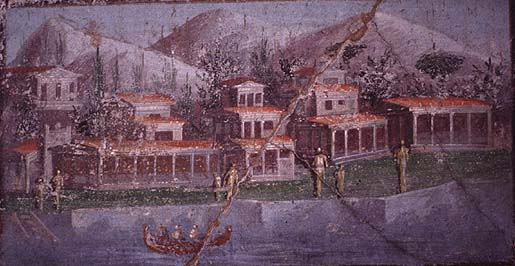Superintendent Massimo Osanna described them as “aristocratic houses.”
The Romulus and Remus house and the Trittolemo house were damaged in World War II bombing raids and never opened to the public until now. The house of Fronto, a prominent politician in 2nd-century Rome, was opened “because it did not require a great amount of resources,” Osanna said.
The buildings will be open at least until May 1, when a labor agreement at the site ends.[ANSA]
© 2014 United Press International, Inc. All Rights Reserved. Any reproduction, republication, redistribution and/or modification of any UPI content is expressly prohibited without UPI’s prior written consent. UPI
~~~~
The Domus of Romulus and Remus
The domus of Romulus and Remus was erected in the second century BC, in the same period when a unique sort of sidewalk, decorated with a pebbles mosaic, was realized in front of the house. Located in a prestigious district of the city, in proximity of a city gate and the main public buildings, the house has a traditional plan: the entrance (a) leads to the atrium with impluvium (b), surrounded by private rooms.
Affresco parete ovest (acquerello
The representative rooms comprise a tablinum (k) and an oecus (n) as well as a small garden (q), surrounded by a portico with fluted columns, paved in cocciopesto (p). The room (t), an alcove, bears traces of the presence of a bed, namely grooves visible on the east and west wall.
The name of the house derives from a fresco which was lost during the bombing of 1943. In the night of August 24 (in tragic coincidence with the supposed date of the eruption in 79 AD) and September 13, two bombs fired by Allied forces hit the domus. The fresco was located in room (n) and represented the legendary she-wolf while suckling the twins Romulus and Remus, founders of Rome (established, according to the legend, on April 21 753 BC).
Inside the house, which was excavated primarily in the years 1871-72, the bodies of five persons were discovered, one of whom died when attempting to escape. His right hand was clapsing numerous gold, silver and bronze coins, while the left hand was clapsing a gold and a bronze ring. Since we know of another lost wall painting depicting Romulus, and since one of the rings bears the initials FA.H, M.
Paràdeisos
Della Corte hypothesized that in 79 AD the house was inhabited by members of the illustrious gens Fabia (hence the initials FA), known for contributing to the college of priests who organized the celebrations commemorating the foundation of Rome during the feast of Lupercalia.
The marble steps at the entrance as well as the discovery of finely crafted objects (including a bronze stool, silver objects, a safe of which the basis of lava stone remains, placed in room (g) reflect the high living standard of the family.
.
The great Fourth Pompeian Style frescos in the peristyle (p) show, on the west wall, statues of nymphs, a fountain and a peacock. Originally, there was also a sleeping satyr. A group of animals is depicted on the north wall: an elephant and a buffalo; a snake and a winged griffin (top), a cow, a gazelle, a donkey, a running fox, a bear and paws of big cats. The scene, placed on a red background with flowering bushes and birds, recalls the theme of the paràdeisos, a garden full of exotic animals. In the central part, which is lost, Orpheus was probably entrancing the animals with the sound of his lyre. http://www.pompeiisites.org/Sezione.jsp?idSezione=1468
.
The Getty museum in California is more or less a replica of one of the houses excavated at Herculaneum. One of the artifacts from the House of Piso is a brazier that stood just inside the front door; the possibility exists (despite the long interval between him and the eruption) that Julius Caesar warmed his hands over it.
.
The House of M. Lucretius Fronto (pics)
https://sites.google.com/site/ad79eruption/pompeii/regio-v/reg-v-ins-4/house-of-m-lucretius-fronto
https://www.google.com/search?q=Marcus+Lucretius+Fronto&tbm=isch
.
The houses are open for viewing. Lots of pics at google.









